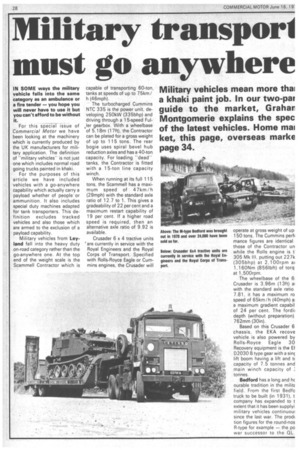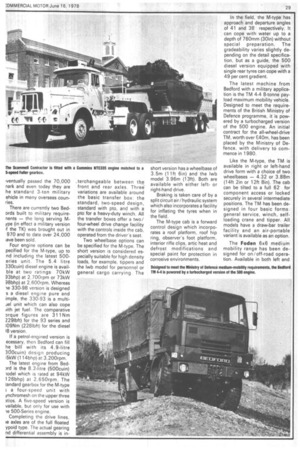Military transporil
Page 30

Page 31

Page 32

If you've noticed an error in this article please click here to report it so we can fix it.
must go anywhere
Military vehicles mean more thai a khaki paint job. In our two-par guide to the market, Grahar Montgomerie explains the spec of the latest vehicles. Home mal ket, this page, overseas marke page 34.
IN SOME ways the military vehicle falls into the same category as an ambulance or a fire tender — you hope you will never have to use it but you can't afford to be without it.
For this special issue of Commercial Motor we have been looking at the machinery which is currently produced by the UK manufacturers for military application. The definition of "military vehicles" is not just one which includes normal road going trucks painted in khaki.
For the purposes of this article we have included vehicles with a go-anywhere capability which actually carry a payload whether of people or ammunition. It also includes special duty machines adapted for tank transporters. This definition excludes tracked vehicles and also those which are armed to the exclusion of a payload capability.
Military vehicles from Leyland fall into the heavy duty on-road category rather than the go-anywhere one. At the top end of the weight scale is the Scammell Contractor which is
capable of transporting 60-ton, tanks at speeds of up to 75km / h (46mph).
The turbocharged Curnmins NTC 335 is the power unit, developing 250kW (335bhp) and driving through a 15-speed Fuliler gearbox. With a wheelbase of 5.18m (17ft), the Contractor can be plated for a gross weight of up to 115 tons. The rear bogie uses spiral bevel hub reduction axles and has a 40-ton capacity. For loading "dead" tanks, the Contractor is fitted with a 15-ton line capacity winch.
When running at its full 115 tons, the Scammell has a maximum speed of 47km / h (29mph) with the standard axle ratio of 12.7 to 1. This gives a gradeability of 22 per cent and a maximum restart capability of 19 per cent. If a higher road speed is required, then an alternative axle ratio of 9.92 is available.
Crusader 6 x 4 tractive units are currently in service with the Royal Engineers and the Royal Corps of Transport. Specified with Rolls-Royce Eagle or Cummins engines, the Crusader will
operate at gross weight of up 150 tons. The Cummins perfr mance figures are identical those of the Contractor un while the Rolls engine is tI 305 Mk Ill, putting out 227k (305bhp) at 2,100rpm ar 1,160Nm (856Ibft) of torq at 1,500rpm.
The wheelbase of the 6: Crusader is 3.96m (13ft) al with the standard axle ratio 7.81, it has a maximum ro speed of 65km /h (40mph) al a maximum gradient capabil of 24 per cent. The fordii depth (without preparation) 762mm (30in).
Based on this Crusader 6. chassis, the EKA recove vehicle is also powered by Rolls-Royce Eagle 30 Recovery equipment is the El D2030 B type gear with a sin( lift boom having a lift and t( capacity of 7.5 tonnes and main winch capacity of tonnes.
Bedford has a tong and hc ourable tradition in the militz field. From the first Bedfo truck to be built (in 1931), t company has expanded to t extent that it has been supplyi military vehicles continuow since the last war. The prod( tion figures for the round-nos R-type for example — the po war successor to the QL
ventually passed the 70,000 nark and even today they are he standard 3-ton military ehicle in many overseas counries.
There are currently two Bedords built to military requirelents — the long serving Mype (in effect a military version. cf the TK) was brought out in 970 and to date over 24,000 lave been sold.
Four engine options can be pecified for the M-type, up to nd including the latest 500eries unit. The 5.4 litre 330cuin) diesel engine is availble at two ratings. 70kW 93bhp) at 2,700rpm or 73kW 98bhp) at 2,600rpm. Whereas le 330-98 version is designed s a diesel engine pure and imple, the 330-93 is a multiel unit which can also cope iith jet fuel. The comparative Drque figures are 311Nm 229Ibft) for the 93 series and ;09Nm (228Ibft) for the diesel l8 version.
If a petrorengined version is ecessary, then Bedford can fill he bill with its 4.9-litre 300cuin) design producing 5k1/11(114bhp) at 3,200rpm. The latest engine from Bed)rd is the 8.2-litre (500cuin) nodel which is rated at 94kW 126bhp) at 2,650rpm. The tandard gearbox for the M-type ; a four-speed unit with ynchromesh on the upper three )tios. A five-speed version is vailable, but only for use with le 500-Series engine.
Completing the drive lines, ie axles are of the full floated ypoid type. The actual gearing rid differential assembly is in
.terchangeable between the front and rear axles. Three' variations are available around the basic transfer box: the standard, two-speed design, standard with pto, and with a pto for a heavy-duty winch. All the transfer boxes offer a two/ four-wheel drive change facility with the controls inside the cab, operated from the driver's seat.
Two wheelbase options can be specified for the M-type. The short version is considered especially suitable for high density loads, for example, tippers and the lwb model for personnel or general cargo carrying. The short version has a wheelbase of 3.5m (lift Sin) and the Iwb model 3.96m (13ft). Both are available with either leftor right-hand drive.
Braking is taken care of by a split circuit air/hydraulic system which also incorporates a facility for inflating the tyres when in the field.
The M-type cab is a forward control design which incorporates a roof platform, roof hip ring, observer's foot platform, interior rifle clips, artic heat and defrost modifications and special paint for protection in corrosive environments. In the field, the M-type has approach and departure angles of 41 and 38 respectively. It can cope with water up to a depth of 760mm (30in) without special preparation. The gradeability varies slightly depending on the detail specification, but as a guide, the 500 diesel version equipped with single rear tyres can cope with a 49 per cent gradient.
The latest machine from Bedford with a military application is the TM 4-4 8-tonne payload maximum mobility vehicle. Designed to meet the requirements of the British Ministry of Defence programme, it is powered by a turbocharged version of the 500 engine. An initial contract for the all-wheel-drive TM, worth over £.40m, has been placed by the Ministry of Defence, with delivery to commence in 1980.
Like the M-type, the TM is available in right or left-hand drive form with a choice of two wheelbases — 4.32 or 3.88m (14ft 2in or 12ft 8in). The cab can be tilted to a full 62 for component access or locked securely in several intermediate positions. The TM has been designed in four basic forms. general service, winch, selfloading crane and tipper. All models have a draw-bar trailer facility and an air-portable variant is available as an option.
The Foden 6x6 medium mobility range has been designed for on /off-road operation. Available in both left and right-hand drive, the chassis has been designed to accommodate various types of specialist equipment such as hydraulic loaders, mechanical winch gear, and with troop carrying, cargo or tanker bodywork.
Rolly-Royce power is used. The 6x6 version has the turbocharged 305 Mk III which produces 227kW (305bhp) at 2,100rpm with a maximum torque of 1,160Nm (856Ibft) at 1,500rpm. The gearbox is the familiar Foden nine-speed design, while the axles are of the hub-reduction type from Kirkstall, the front having an 8-ton capacity and the bogie a 20-ton capacity.
The designed gross vehicle weight is 28.4 tonnes (28 tons) on a wheelbase of 5.49m (18ft). The Foden definition of "wheelbase" is equivalent to the outer axle spread. Equating this to the more usual mid-bogie definition, the wheelbase is 4.73in (15ft Gin).
The all-steel S90 cab is featured on the military Fodens, with the radiator being hinged for access before the cab is tilted. This particular cab tilts to 45 for normal servicing but special provision has been made for a maximum angle of 65 should the engine need to be removed.
Braking is by means of a full air split circuit system with spring brake chambers on all axles to take care of the parking requirements. Marshall of Cambridge has designed a range of bodywork specifically for the Foden range. For use as a tractive unit for the FH70 towed gun, the Foden is air-portable in Belfast and Hercules aircraft. The platforms comprise two sections of underframe with hardwood boarded floors, mounted fore and aft of the loading crane. Shackles fitted to the platforms can secure up to four NATO ammunition pallets.
To suit the 16-tonne cargo version, the platform consists of a welded steel underframe with a hardboard boarded floor and steel wearing strips, mounted between the spare wheel at the forward end and the rearmounted loading crane The body in general is manufacture from mild steel sections an sheet and is of welded an bolted construction.
In the on-road range, the 6x Foden has a maximum speed 109km/h (68mph) wit 54krnih (34mph) being th equivalent maximum in the la range. At a gvw of 27 tonne: the theoretical gradeability is 5 per cent as a 6x6 and 25 pi cent in 6x4 form.
Many of the aforementionc points apply also to the lov mobility Foden range, includir the use of Fodens' own gearbo Although Rolls-Royce engin( are again specified, they are the Eagle 220 variety devi loping 164kW (220bhp) 2,10Orpm.
Available in sixand eigh wheeler configuration, the lo mobility machines use FodE worm-drive axles instead of tF Kirkstall units listed for tf medium-mobility design. Tf rear bogie has a design rating 19.5 tons. Axle location is pr vided by centrally mounted tr que rods connecting the wor gear housing to the frame ar by four torque rods mount( beneath and parallel to tF springs.
The maximum speed of tl low mobility Foden is 87km; (54mph) for the 6x6 tanker ar 76km /h (47mph) for the 8) variants. Depending upon ti detail specification, gradeabili varies between 25 and 32 p cent..
















































































































